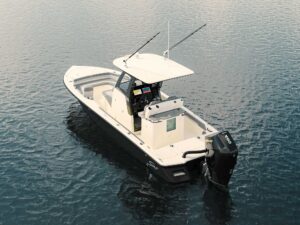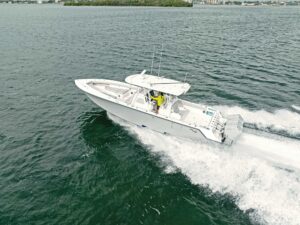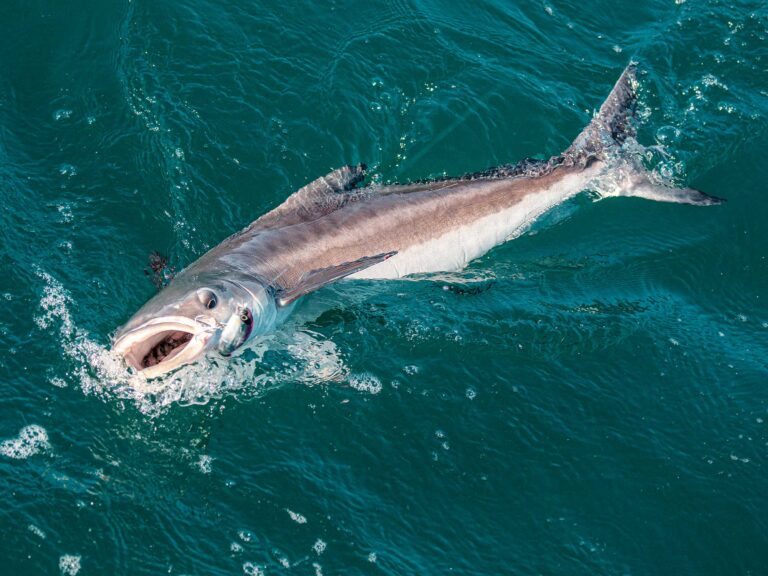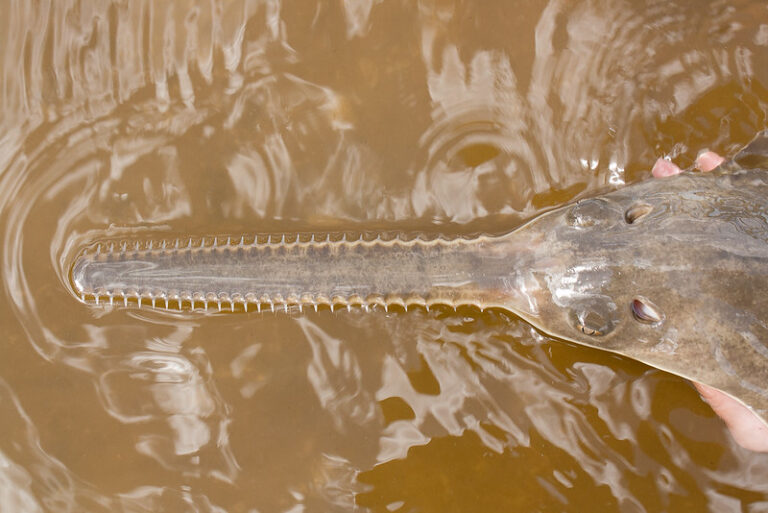
| “The pocket transom and shallow draft (11 inches) allow it to run in some pretty skinny water.” |
What do you get when you take marine-grade polyethylene powder, pour it into a high-tech aluminum mold, then shake and bake it in a computer-controlled four-story oven? Answer: The 186 Cool Bay, the latest debut from Triumph Boats.
Triumph uses the patented “Roplene” construction technology just described to build all its models, and the 186 was designed to fill the niche for bay and near-coastal anglers. By using polyethylene instead of fiberglass and a three-stage shuttle oven to first mold, then cool the material, Triumph produces a seamless, double-walled hull without any deck joints. The process also reinforces weld points in the stringers and other stress areas for strength and rigidity. All internal cavities are filled with foam for flotation and sound deadening, while cleats and other components are screwed into molded-in, stainless-steel anchor points. The Cool Bay’s hatch covers and decking are made of skid-resistant StarBoard, which makes the entire boat extremely easy to clean, but the construction attributes don’t stop there.
Fantastic Plastic
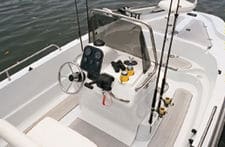
Because plastic’s composition includes air molecules, the finished hull is buoyant and incredibly tough, as I discovered during a test on Florida’s St. Marks River and Apalachee Bay. Triumph representative Jeff Gross started the demonstration by clubbing the boat with a steel pipe ¿¿ la Jackie Chan with no visible hint of damage. My impression meter pegged after Gross insisted that I intentionally ram the boat at fast idle into a steel I-beam channel marker. Other than some bird poop on the rub rail, the Cool Bay was none the worse for wear.
“The air molecules distribute the shock waves throughout the polyethylene, so there’s little chance of damage. It has five times the impact resistance of fiberglass,” Gross explained. “This is the rental-car version of boats. You can’t hardly hurt it, so owning and operating one is less intimidating to novice boaters. If you do happen to damage the hull, repairs can be made with sandpaper, poly paste and a propane torch. The hull color is impregnated in the mold, so there’s no gelcoat to repair.”
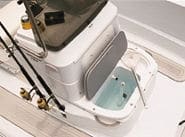
Our test 186 was powered by a 135-hp Johnson outboard, and it handled the moderate chop and boat wakes with only misting from wind-blown spray. Not only does the hull provide a soft, dry ride, the pocket transom and shallow draft (11 inches) allow it to run in some pretty skinny water. As far as speed is concerned, Triumph says the boat, when powered by a standard 115-hp two-stroke, will cruise at 26 mph at 3000 rpm and top out at 43 mph at 5800 rpm.
The Cool Bay 186 comes equipped with ample fishing features, including a pre-wired trolling-motor mount pad on the bow and a twin-battery storage locker below the forward casting deck. The forward deck has twin fishbox/storage compartments, plus a built-in mount so you can add an optional bow fishing chair. A 60-quart bait well with aerator pump is located under the cushioned forward console seat, and there’s both horizontal and vertical rod holders straddling the console.
| ¿ SPECIFICATIONS LOA: 18′ 6″ Beam: 8′ 1″ Transom deadrise: 14 ¿ Draft: 11″ Displacement: 1,500 lbs. Fuel: 37 gals. Base price w/115-hp outboard: $12,995 |
The console houses a standard instrumentation package including tachometer, speedometer, compass and fuel gauge, while the combination 72-quart cooler/helm seat (hence the name, Cool Bay), provides easy operation and good visibility. No-Feedback steering, a 37-gallon fuel tank and an automatic 500-gph bilge pump are also standard, while a Bimini top can be added as an option.
In the classic movie, The Graduate, the character played by Dustin Hoffman was offered a word of advice regarding his future: “Plastics.” With the introduction of the Triumph Cool Bay 186, I’ll add two words of my own: “Cool boat!”
Triumph Marine, Durham, NC; (919) 382-3149; www.tiumphboats.com.

